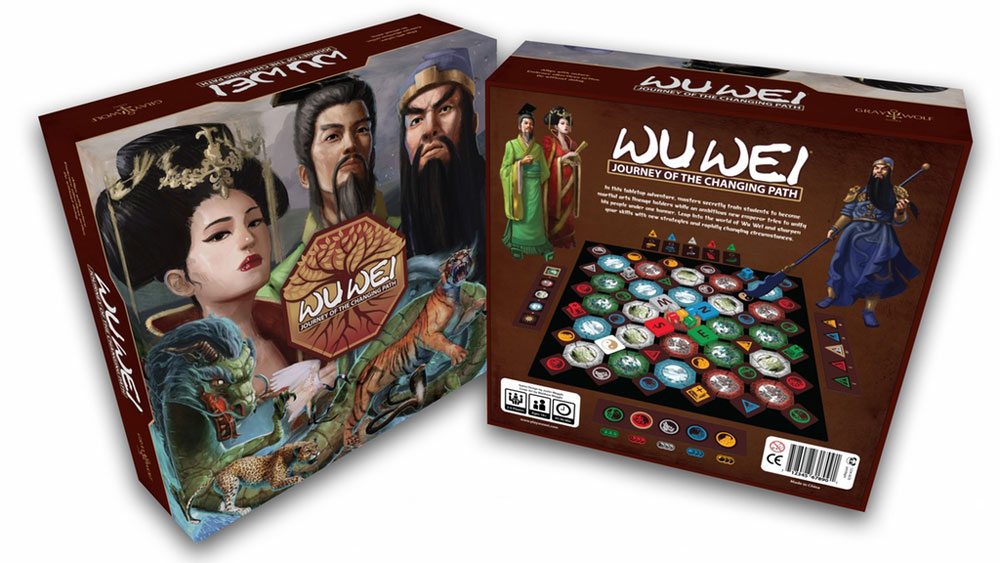Three years ago, I wrote about a game on Kickstarter called Lineage, which was inspired by martial arts philosophy. Unfortunately, the campaign did not reach its funding goal, but designer Justin Waggle promised to keep working on the game and relaunch it. Well, it took a little longer than anticipated, but the game is back on Kickstarter now as Wu Wei: Journey of the Changing Path, after significant revamping.
At a glance: Wu Wei is an abstract strategy game for 2–6 players, ages 14 and up, and takes 45–90 minutes to play, depending on number of players and mode of play. (I will warn that the first time you play, you should expect a significantly longer time for learning the rules, but the game does go more quickly after that.) It is currently seeking funding on Kickstarter, with a pledge of $59 for a copy of the game. I would say the game is rated 14+ primarily because there are a lot of rules to track, but there is nothing inappropriate for younger kids. My 10-year-old has played it and enjoys it, though piecing together all of the rules for an effective strategy has been a bit tough for her.
New to Kickstarter? Check out our crowdfunding primer, and visit our Kickstarter curated page for more projects we love.
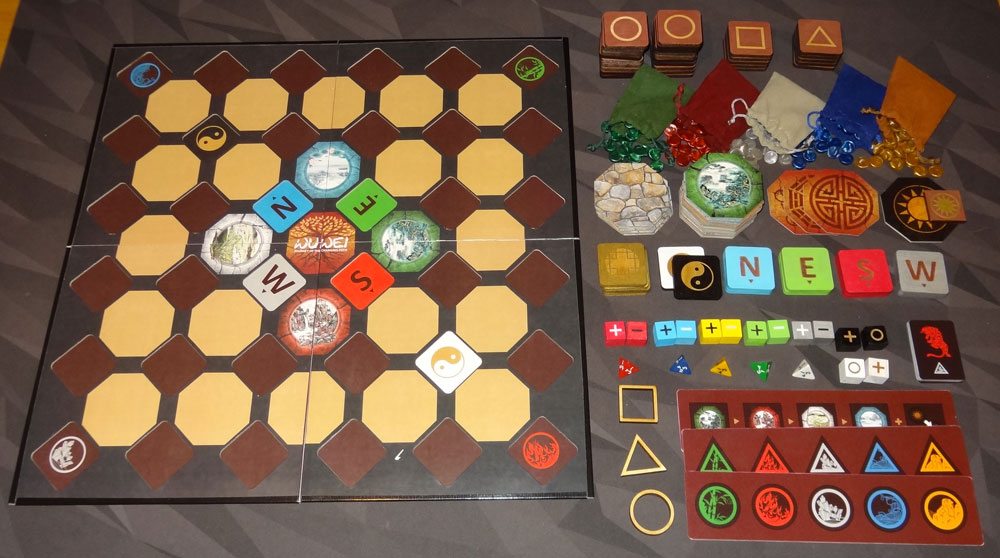
Components
Wu Wei comes with a lot of components. (Note: my review is based on a pre-production prototype, and as such many of the components are not final and are subject to change. Visit the Kickstarter page for more information and the most updated components list.)
- 24 double-sided octagonal terrain tiles
- 36 square tiles:
- 2 Yin-Yang tiles
- 4 Directional tiles
- 5 Temples (squares)
- 5 Palaces (triangles)
- 20 Towns (circles)
- 8 octagonal wall tiles
- 4 tower tiles
- 180 “chi” tokens (36 each in blue, red, yellow, green, silver)
- 5 Lineage markers
- 5 Student pawns
- 5 Master pawns
- 1 Emperor/General pawn (white)
- 1 Empress/General pawn (black)
- 2 General pawn (1 white, 1 black)
- 1 First Player marker
- 3 Center Octagons
- 3 Status trackers
- 1 Temple tracker board
- 1 Palace tracker board
- 1 Town tracker board
- 1 game board
- 1 Gathering marker
- 25 Animal cards (5 each: leopard, tiger, crane, dragon, snake)
- 6 Player Aid cards
The prototype is absolutely gorgeous, though final results are subject to change—I’m not actually sure how many of the pieces will be wood vs. cardboard or plastic.
The game board is a new edition since the last time—it helps with set up, holding the various tiles in place. It’s also double-sided. One side has a sample set up printed on it, and the other side is mostly blank so you can use a randomized setup.

The player pawns are all cubes of different colors, and each has various symbols on the top and bottom faces: “-” for Students,
“+” for Masters and Generals, and “o” for Emperor and Empress. The symbols are either black or white, which has an effect on which pieces you are able to move. (The Emperor, Empress, and General pieces are black and white themselves, so the symbols are gold colored instead.)

The artwork on the tiles and cards is by a Chinese artist, Yan Li. The terrain tiles are traditional Chinese paintings depicting forests, lakes, mountains, marshes, and fields. There also various types of animals or element types, and these are more stylized but fit really well with the theme.
One thing about the game components is that there aren’t a lot of text instructions or even that many icons printed on the various game components other than the player aid card, which means that you do need to learn to “read” the game yourself. It can be a bit opaque if you haven’t read the rulebook yourself and you’re wondering what all the trackers do and what the cards mean. I think it does make for a really beautiful game, but it can feel a bit lacking in functionality. The directional tiles are there to indicate what directions the four quadrants are, but it’s not immediately obvious that you can’t step on them because you can step on any of the other square tiles. Think about a standard chess set, and the way that the pieces don’t tell you how to move them or where to put them for set up: once you’re familiar with the game, you really don’t need starting positions printed on the board, or a summary of each piece’s movement, and that sort of thing would clutter up the board. However, it does mean a higher barrier to entry when you’re getting started.

How to Play
You can download a copy of the rulebook here. While no individual rule is particularly hard, there are just a lot of them. However, the three gameplay modes help you learn a bit of the game at a time, so you generally wouldn’t jump into the Emperor level all at once. The three modes are: Disciple (2–5 players, 45 minutes), Master (2–5 players, 60 minutes), and Emperor (3–6 players, 90 minutes).
I’ll note that because the game is meant to be introduced one mode at a time, my summary of everything may be a little overwhelming, but feel free to jump down to “The Verdict” if you just want to find out what I liked and disliked about the game.
Objective: Most of the players will each be controlling a Master and a Student—their objective is to train the Student (by claiming 5 animal cards), and then move the Master and Student both back to the center tile. In the Emperor mode, one player will control the Emperor and General—the Emperor wants to unite the kingdom under one banner, and wins by placing towers on the four corners of the board.
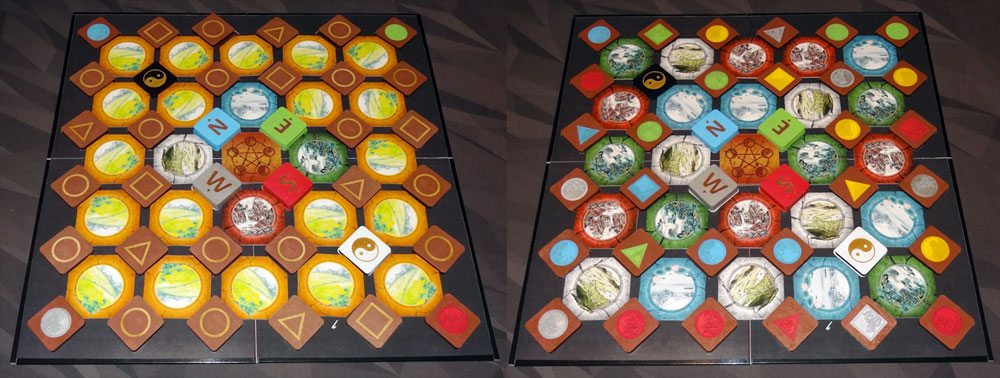
Setup: The board setup is randomized, with a few static elements: the center tile must always be surrounded by one of each season (Spring Forests, Summer Mountains, Autumn Marshes, Winter Lakes), and the four directional tiles. The Yin-Yang tiles are placed to the north and south of the center tile beyond another row of terrain, and the four corners must be towns (the tiles with circles) representing Wood, Fire, Metal, and Water. The rest of the terrain tiles are randomly placed (face-down) to fill out the board, and the other square tiles are randomly filled in (face-down), though no octagon can be adjacent to two temples or two palaces—they must be spread out more. Once all the tiles are placed, everything is turned face-up to reveal the colors.
The three tracker boards are placed to the side, with the tracker markers on them—the player last in turn order gets to decide where to start each tracker marker.

Each player gets a lineage marker, a four-sided die matching their color, as well as a Master and a Student. Masters start on their matching temple, and Students start in the center with the “-” side face-up. Everyone also collects 1 chi of each color, and players will also get additional chi in turn order (to make up for first player advantage).
Depending on the mode of play, there may be additional setup, particularly for the Emperor player, though I won’t get into too much detail here. The Emperor gets to start off with some terrain flipped over to the “fields” face, and then build walls on them.
On your turn, you do 4 things: Meditate, Move, Align With Nature, and Develop Discipline.
Meditate: This means that you check the state of the two yin-yang tiles to determine what you can move this turn: the colors showing indicate which of your pieces you may move, black or white. (In the Master and Emperor modes, the yin-yang tiles can be triggered to flip them over.) So if both yin-yang tiles are black at the start of your turn, you may only move your black piece, not your white piece. You may typically only move one of your pieces, but if you have two Masters in play, you may split your movement between both. If the piece you are supposed to move cannot move, then there are penalties for being “undisciplined”—Students lose an animal card (potentially losing their Master status), and Masters lose their lineage marker, flipping to the “-” side until they get back to the Palace to reclaim it. You also get sent back to the center octagon for being undisciplined.
Move: Move your piece 1, 2, or 3 spaces, without retracing any steps. Basically you can move to spaces that share a side, though there are some restrictions: you can’t move back into the center (until you have both Masters ready), you can’t step on the directional tiles, and there are restrictions on which characters may share a space. (Like repels like, as in magnetism.) One very important restriction is that you can never move onto a terrain tile that matches the current season, as shown on the Temple Tracker board.
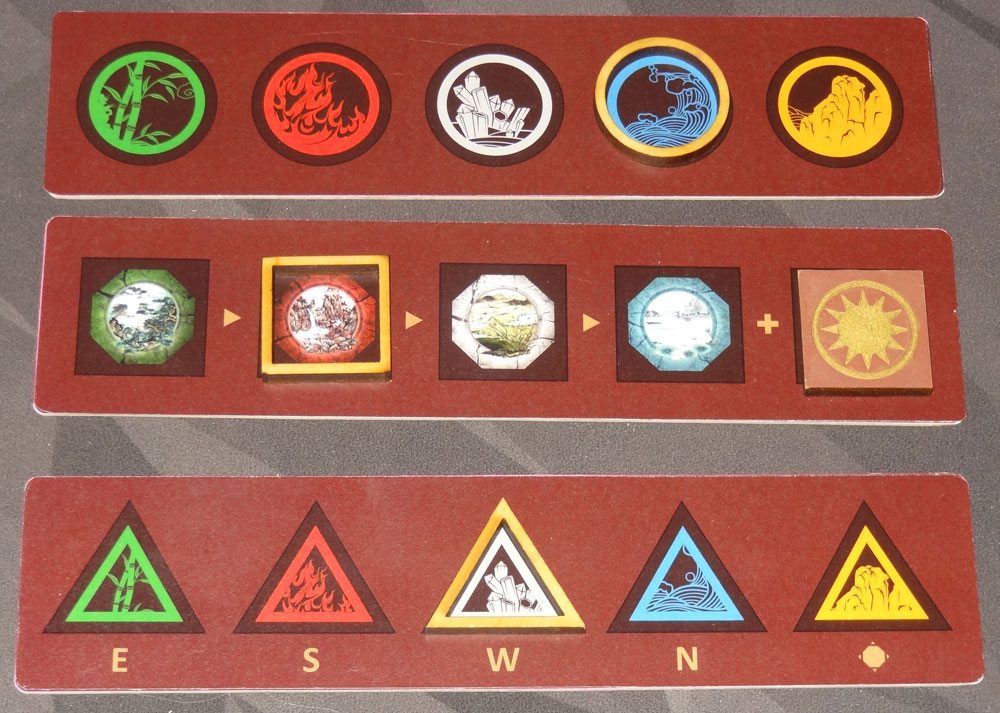
Align With Nature: If you end your movement on one of the square tiles (Temple, Palace, Town), then a couple of things happen. First, you collect 1 chi of the matching color. Then you’ll also move the appropriate tracker.
- Temple: Advance the Temple tracker 1 space, which changes the season (and the impassable terrain type). If it becomes winter, flip over the Gathering marker to the “moon” side, triggering a Gathering before the starting player’s next turn.
- Palace: If the Palace you ended on is not exhausted (where the triangle marker is currently), then you get to build a wall or flip over a terrain tile in the specified quadrant, and then move the tracker to that Palace (which exhausts it). The back side of the terrain tile is a field, which is always passable.
- Town: Move the Town tracker to the type of Town you landed on. The Town tracker indicates what type of chi is active and may be used—other types cannot be spent.
Develop Discipline: If your Student is in the same space as a Master at the end of your turn, you may train with that Master by taking a matching animal card from the supply. You may only have one of each animal card, and once you have all five, you flip the Student over to become a Master. Also, during this step your Master cultivates chi—if you have at least one Master in play, then you take 3 chi of your native element (the one matching your color).

There are some other rules in play, of course. Chi (of the active type according to the Town Tracker) can be used for a few different things: extra movement points, to activate your animal cards, to break walls, and to push/pull other pieces. Each animal card gives you a one-time-use ability—most let you jump to a particular location on the board, and the Snake lets you move onto a wall.
I mentioned the “Gathering” triggered by the seasons. Once a Gathering is triggered, before the starting player’s next phase, everyone bids chi (of the active type) for the privilege of choosing the starting player. Whoever bids the most chi makes the decision. Win or lose, whatever chi you bid is distributed to your opponents however you choose.
The goal is to train your Student, and then move both of your Masters to the center octagon—if you do this, you win the game!
The Emperor mode adds a new player with different mechanics and a new objective: to build 4 towers in the corners of the board. The Emperor and Empress can turn terrains into fields as they move over them, and build walls where they end movement. The General may not move on face-up terrain tiles (so he relies on fields and walls), and if he reaches a corner, he gets to build a tower. He can also conscript Masters and Students if he ends up in the same space as them (there are “+” and “-” Generals), enacting a penalty and sending them back to the center. As the Emperor player builds towers, they may earn up to two more pawns, but when the Emperor player is blocked from moving, they will lose towers.

The Verdict
When I reviewed Wu Wei (as Lineage) three years ago, I gave it a thumbs-up: I loved the way the game looked, I thought the asymmetric play with the Emperor player was very intriguing, and I liked the overall gameplay. Many of the things I criticized have been changed since that initial version, though the core of the game is the same. The board makes the game easier to set up, and the trackers are much easier to use than the decks of cards from the previous prototype.
One of the major changes is the way that the game now has three modes of play, so that you can learn the rules in three sections rather than all at once (which is what I’ve kind of thrown at you here in this post). In the old version, the 2-player version didn’t have the Emperor player, and I mentioned that I thought it might be a nice way to learn some of the basics but wasn’t quite as interesting. I like the way that the game now uses these different modes to ease you into it—but I still do think that Emperor mode is the “full” experience that you should eventually work toward.
There’s a lot of fascinating give-and-take going on in the ways that you manipulate the elements and the seasons to open up a path for yourself or close off paths for other players. The easiest example of that is the seasons—since you cannot move into a terrain of the current season, moving to Temples so that you can advance the season is often an effective way to open up a path that was blocked. Another (in the Master and Emperor modes) is to trigger the yin-yang tiles. If you turn them both to the same color, then it forces the next player to move that particular color, trapping the other color in place until somebody flips a yin-yang tile back over.
Another example of the give-and-take is in the pushing and pulling of pawns. If you want to move into a space that is currently occupied by another pawn that you can’t share space with, you must first push it out by spending chi. The other player may spend chi to resist, in which case the push fails. But if they don’t resist, then they actually get the chi that you spend. Bidding a lot of chi to become starting player also means that you’ll give a lot of chi away to other players.
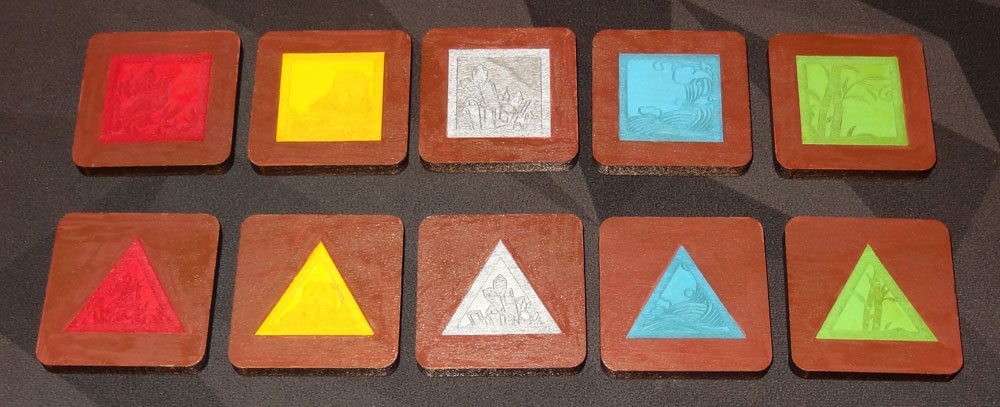
If you’re curious about how Taoist philosophy and martial arts influenced the gameplay, check out Waggle’s interview with Bin Lee of Part Time Movie Guy. (Note to parents: the video does include some language and content that may not be appropriate for kids.) This interview was done a while back, for the first Kickstarter campaign, so some gameplay elements have changed a bit since then. Waggle explains the gameplay and also details how the colors, seasons, animals, and elements are tied to the philosophy.
My main quibble with Wu Wei is the learning curve, due in part to some of the issues I mentioned in the “Components” section above. The game looks fantastic, but it isn’t intuitive. There are all these inter-related colors and shapes: blue means water, and winter, and Dragon, and it’s a player … the meaning depends on the context. It’s easy to feel lost when you first approach the game and somebody says “Oh, you can step here, but not here. You can move this pawn, but not that pawn.” I’ve had mixed reactions to the game with my gaming group: there have been some players (including myself and my 10-year-old daughter) who really enjoy it, and there have been some who were frustrated at the sheer number of rules—though I admit that may be due to my rushing them through the explanation so we could start playing. However, once you’re familiar with the rules, the various restrictions and connections do start to make sense and there are some very cool mechanics at play. I hope people stick with it long enough to get to that point.
Wu Wei is one of those games that will attract passersby at a convention just because it looks so elaborate when it’s all set up. If you’re a fan of abstract strategy or if you want to see a martial arts game that isn’t about flying kicks and throwing punches but digs deeper into the philosophy, Wu Wei is certainly worth checking out. It’s perhaps not a game for everyone—you do have to have patience learning the rules and how to read the board and trackers—but I think it is rewarding for those who are, ahem, disciplined enough to master it.
For more information or to make your pledge, visit the Wu Wei Kickstarter page today!
